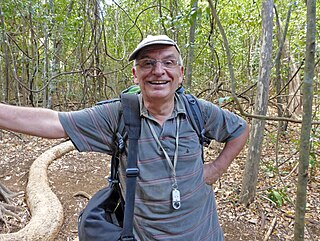
The Gomphillaceae are a family of lichen-forming fungi in the order Graphidales. Species in this family are found mostly in tropical regions.
Actinoplaca is a genus of fungi within the Gomphillaceae family.
Arthotheliopsis is a genus of fungi in the family Gomphillaceae. It has 5 species. The genus was circumscribed by Finnish lichenologist Edvard August Vainio in 1896, with A. hymenocarpoides assigned as the type species.
Calenia is a genus of lichen-forming fungi within the family Gomphillaceae.
Diploschistella is a genus of fungi within the family Gomphillaceae.
Echinoplaca is a genus of lichens in the family Gomphillaceae.
Ferraroa is a single-species genus in the family Gomphillaceae. It is a monotypic genus, containing the single species Ferraroa hyalina, a foliicolous (leaf-dwelling) lichen. This species was originally described by Robert Lücking in 1997 as Gyalideopsis hyalina. The type specimen was collected from leaves of Inga oerstediana in Costa Rica. Lücking, Emmanuël Sérusiaux, and Antonín Vězda transferred the taxon to the newly circumscribed genus Ferraroa in 2005 after molecular phylogenetic analysis showed it to belong to a unique lineage. The generic name Ferraroa honours Argentinian lichenologist Lidia Itatí Ferraro, "for her many contributions to lichenology in southern South America, and to our knowledge of Gomphillaceae".

Gomphillus is a genus of lichens in the family Gomphillaceae.
Gyalectidium is a genus of lichen-forming fungi in the family Gomphillaceae. A 2020 estimates placed 52 species in the genus. The genus was circumscribed by Swiss lichenologist Johannes Müller Argoviensis in 1881. He included 3 species: G. xantholeucum, G. dispersum, and G. filicinum; the last of these is now the type species of the genus.
Hippocrepidea is a genus of fungi in the family Gomphillaceae. This is a monotypic genus, containing the single species Hippocrepidea nigra.
Jamesiella is a genus of fungi in the family Gomphillaceae. The type species of the genus, Jamesiella anastomosans, is now classified in the genus Gyalideopsis.
Paratricharia is a genus of fungi in the family Gomphillaceae. It is a monotypic genus, containing the single species Paratricharia paradoxa.
Rubrotricha is a genus of lichen-forming fungi in the family Gomphillaceae. It is a monospecific genus, containing the single species Rubrotricha helminthospora.
Rolueckia is a genus of leaf-dwelling lichens in the family Gomphillaceae. It was circumscribed in 2008 by Thai lichenologists Khwanruan Papong, Achra Thammathaworn, and Kansri Boonpragob. The three species in the genus were formerly part of the Calenia conspersa group, previously part of the genus Calenia. The type species, Rolueckia conspersa, was first described as Thelotrema conspersum by James Stirton in 1879.

Emmanuël Sérusiaux is a Belgian lichenologist. His career, spanning more than four decades, has combined both lichenology research and political aspects of nature conservation. He spent several periods working as a researcher at the National Fund for Scientific Research and the University of Liège, the latter in which he accepted a faculty position as professor and head of the Plant Taxonomy and Conservation Biology unit. Sérusiaux also served for three non-consecutive appointments as Deputy Chief of Staff in the Government of Wallonia. He retired from both his academic and political positions in 2019.

Gyalideopsis buckii is a species of bark-dwelling lichen in the family Gomphillaceae. It is found in the United States.
Arthotheliopsis serusiauxii is a species of leaf-dwelling lichen in the family Gomphillaceae. It was first formally described as a new species in 1997 by Robert Lücking, as a member of genus Echinoplaca. The type specimen was collected in Costa Rica, growing on the leaves of a dicotyledon. The specific epithet honours Belgian lichenologist Emmanuël Sérusiaux. In 2005, Lücking, Sérusiaux, and Antonín Vězda transferred it to genus Arthotheliopsis after a molecular analysis of the Gomphillaceae helped to clarify the phylogenetic relationships in the family.
Gyalectidium yahriae is an uncommon species of crustose lichen in the family Gomphillaceae. It occurs in Florida and Papua New Guinea, recorded growing on bark in the former location and on both bark and on wood in the latter.

Robert Lücking is a German lichenologist. He earned his master's and PhD from the University of Ulm, focusing on the taxonomy, ecology, and biodiversity of foliicolous lichens. He has received numerous awards for his work, including the Mason E. Hale award for his doctoral thesis, the Augustin Pyramus de Candolle prize for his monograph, and the Tuckerman Award twice for his publications in The Bryologist. Since 2015, he has been serving as the curator of lichens, fungi, and bryophytes at the Berlin Botanical Garden and Botanical Museum, and several lichen species and a genus have been named in his honour.
Graphidales is an order of lichen-forming fungi in the class Lecanoromycetes. It contains 6 families, about 81 genera and about 2,228 species. Family Graphidaceae are the largest crustose family within Graphidales order comprising more than 2000 species, which are widely distributed in tropical and subtropical regions of the world.



